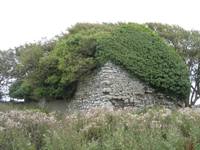The Second Millennium
by Sorcha Hartley
One thousand years ago, the population of the entire country was approximately 500,000. Many of these people lived in or near the towns, which had been established by the Norsemen during the previous century. Rural areas like our own parish were sparsely populated. Ireland has been described at the dawn of the last millennium, as a land full of woods, bogs and lakes. Wild pigs were common. Woods and mountains contained large numbers of red deer as well as wolves, which made it necessary for the livestock to be brought in at night, into bawns [bawn or badhún: the defensive wall surrounding an Irish tower house] or enclosures, or else into the dwelling houses themselves. Hedges and fences were very rare, and in most areas, enclosed fields seem to have been almost unknown.
The view which one now sees from Dunhill castle differs a great deal from that which must have been enjoyed by the Barons of Dunhill. These were the descendants of Sir Robert le Poher, who accompanied Henry II when he landed at Crooke, near Passage East, on the 17th October, 1171.
Our own parish of Dunhill and Fenor corresponds to the three ancient parishes of Dunhill, Reisk and Islandkeane, which were united over 300 years ago. This is a maritime parish and was, up to the beginning of the 20th century, a breac Gaeltacht. It covers an area of 13,679 acres and had a population of 952 at a parish census taken in April 1974.
Each of the three ancient parishes had its own pre-Reformation church, the ruins of which are still standing today. At least nine early Celtic church sites have been found and identified in the parish – Kilfarrassey, Ballylenane, Killown, Killsteague, Kilcannon, Smoor, Ballydermody, Ballyphillip, and Kilcarton.
The ancient parish church of Dunhill, situated about 300 yards to the west of Dunhill Castle, was of considerable size. It was erected about the beginning of the 13th century to replace the small Celtic churches in the area. The east gable of the church still stands, densely covered with ivy.
During the penal times, the people of our parish, in company with the majority of the Irish population, had to endure the hardships and rigours of religious persecution. At that time the church of the parish was a thatched chapel, which stood at Cappagh, on the townland of Shanaclune. This chapel at Cappagh was demolished in 1798, and replaced by another thatched chapel on the site of the present church. After a short time this, in turn, was replaced by the slate-roofed church, which served the parish until 1883.
During the years of the great famine, Fr. Michael Walsh was parish priest of our parish. In 1857, just a few years after the famine, the women of the parish gave their jewellery to be made into a beautiful golden chalice in thanksgiving for having survived this dreadful ordeal. This is the chalice which Fr. Purcell will use during our Mass today.
The building of our present church here at Dunhill commenced on March 1, 1883. This church was built outside the walls of the previous church.
 The ruin of the old parish church at Islandkane stands within its ancient cemetery. The total length of this small, ancient church was only 56 ft. Some of the stones from this church were removed and used in the building of Newtown House near Tramore. A silver chalice, which bears the inscription ‘The gift of Mr. Robert Power to the Parish of Island Kane in the County of Waterford, the 17th of April 1742’ is now kept in the Church of the Immaculate Conception at Fenor.
The ruin of the old parish church at Islandkane stands within its ancient cemetery. The total length of this small, ancient church was only 56 ft. Some of the stones from this church were removed and used in the building of Newtown House near Tramore. A silver chalice, which bears the inscription ‘The gift of Mr. Robert Power to the Parish of Island Kane in the County of Waterford, the 17th of April 1742’ is now kept in the Church of the Immaculate Conception at Fenor.
The church at Fenor was erected in 1893 on the site of the previous church. The old church at Fenor was a thatched chapel and was under the patronage of Our Lady’s Nativity.
Nothing now remains of the walls of the parish church at Reisk except the middle gable. This church is very old and incorporated an archway built by the Normans, probably about the year 1200, much later than the rest of the church. In any case Reisk was a church of more than ordinary importance and was one of the largest in the Barony. A silver chalice inscribed ‘The gift of Mr. Geoffrey Hearn and Mrs. Margaret Hearn to the parish of Reisk’ is now kept here in Dunhill church.
Dún Aill, one of the three villages in the Parish of Dunhill and Fenor, derives its name from the ancient fortress, or Dún, which was situated on the rock where the castle now stands, commanding a magnificent view of the surrounding countryside.
During the first half of the 20th century, John Williams described some of the principal surroundings of Dunhill Castle and the story of the siege of the castle, in verse.
